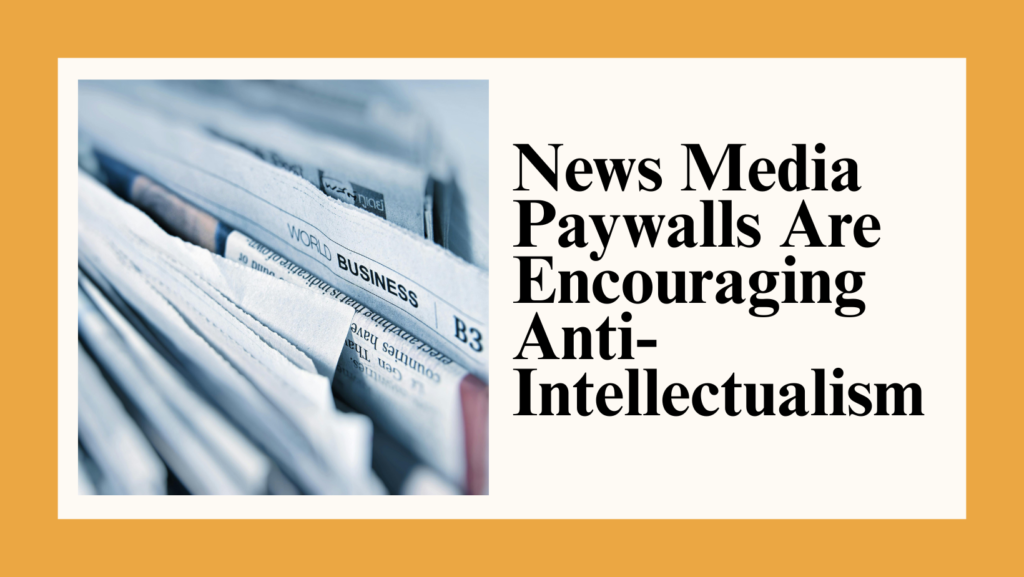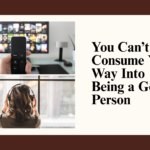The current media ecosystem is set up to make you lazier while feeling more connected than ever. In this essay I’m going to critically explore the rise in media paywalls and how they have contributed to a rising tide of anti-intellectualism.
While not responsible for all the blame, paywalls have created inaccessibility in news access leading to a proliferation of free-to-access sources that do not have journalistic credibility or standards. In turn, people are more likely to receive news from non-journalistic sources and through incidental exposure, leading to apathy, radicalization, intolerance to other viewpoints, misinformation and conspiracy theories.
What is a media paywall?
A media paywall is a financial barrier to accessing news content online. Chances are you have come across a paywall on a website before. Perhaps a warning that you’ve reached your free article limit, or being unable to access any articles without paying for a subscription. Some companies have partial paywalls, where some content is free to access or you can access a limited number of articles. Others have full paywalls that require a subscription for any content.
With a shift to digital news consumption, media paywalls became more common across the journalism ecosystem. Newspaper sales used to account for a large chunk of an organization’s revenue. The rise of the internet, smartphones, and social media in the 2000s caused sales to fall and news organizations to pivot to online revenue generation.
There is a rising trend of people accessing news on social media, and this is especially true for younger demographics. While traditional media (radio, television, print) are still staples for older generations, those under 35 are turning towards podcasts, online news websites, and social media to stay informed.
The Rise of Anti-Intellectualism
These shifts have occurred ahead of what I consider to be a rise in anti-intellectualism from the mid-2010s onward. Anti-intellectualism, very well-named, is an opposition to intellectualism. How this manifests is largely as a mistrust of intellectuals, science, and a questioning of established knowledge. This mistrust gradually builds over time, which I’m arguing had significant germination during the digital shift.
Anti-intellectualism has existed since intellectualism itself. Often beginning as a genuine questioning of how knowledge was created (i.e., how we came to know things), the seeds of mistrust become watered with conspiracy. While questioning authority can and should be encouraged, when questioning becomes linked to stereotypes (e.g., the Jewish cabal running the world) or resistance to overwhelming evidence (e.g., vaccines) it becomes anti-intellectual.
Accessibility is Addicting
With the proliferation of the internet, accessing information for free became much easier. Though libraries have been utilized for many years, having an encyclopedia at your fingertips or, at the very least, your family computer, increased the demand for all information to be accessible, including news.
As news organizations struggled to remain financially solvent with the rise of digital demand and decrease in physical demand, the media paywall came into view. And alternative media found an opening.
Wherever there is a mainstream, there is an alternative. In the physical media world though, circulation of alternative media was small and relatively contained, at least geographically. But the internet age allowed alternative media to flourish.
Alternative Sources Turn Mainstream
It’s a simple road map, really. When mainstream media starts to charge for accessing articles online, you offer an alternative version of the story for free. You frame it as a story ‘so important’ that you would never dream to put it behind a paywall. Your organization is on a righteous mission to spread information. You cultivate a loyal following who believes in your form of truth and then you can generate your revenue through a donation system and merchandise.
The internet and social media specifically, democratized mass media and let everyone have a voice and for those voices to be heard. While there are obvious benefits to this, including underrepresented and marginalized voices being platformed it also was ample breeding ground for conspiracy and misinformation.
Alternative media can prey on people’s genuine questions of authority and truth, and provide easy answers that are presented in free and easy to read content. Social media paved the way for an ecosystem where information is shared quickly and easily, but it provided little opportunity for revenue generation. This killed the momentum of legacy media, but provided a pathway for small companies (or individuals) to risk revenue as they built an audience.
Threats to Local News
The digital paywall has significantly impacted local news coverage. The urgency and grandiosity of international or national news has taken up headlines and importance in people’s minds, blocking the often quite boring but important local news that impacts people more directly. The vie for shareable content proves difficult for personal networks which are often spread geographically. Your friend in your hometown, your friend in the capital, your friend in another country, are all facing different local issues. However, national or international news feels more unifying across our networks, so it becomes the most socially important form of news coverage.
New News
In a past romanticized world, reading, listening, or watching the news was more habitual. Even for my generation, I remember watching the morning news with my parents before school. Now, as people opt for their aux cord, streaming services, and podcasts, the traditional access routes for news are no longer built into our lives. This coincides with news consumption being seen and felt as a duty or chore. In other words, a burden.
Instead of accessing news as a normalized activity, it has become an extra step that requires attention, effort, and often money.
A rise in individualism has also impacted news consumption. Social media algorithms have created a comfort and familiarity with tailored content. In traditional newscasts, you heard all forms of news: economic/financial, political, sport, leisure, pop culture etc. Now, news can be tailored to your interests, forcing us into smaller, less diverse boxes. Legacy media has embraced these trends, with a general focus more towards personal interest and soft stories.
When I hear those on the right complain about liberal media bias, I think this is where it stems from. Personal and soft stories are what generate clicks and bring in the larger audiences, so legacy media pushes them. Of course, it’s pretty disingenuous to call this ‘liberal’ simply because the stories often delve into systemic discrimination of some sort. But there is some truth to the idea that financial, economic, and political debates and stories are deprioritized in this ecosystem.
I’m certainly not trying to paint all those on the right as engaging in conspiracy or alternative media, but I can certainly understand how the pipeline is appealing. Not everyone will tumble down that pipeline, but I think it’s smart to understand how misinformation, anti-intellectualism, and social media have created that path.
Onwards…?
I find it to be a waste of time to harp on the past and any romanticism about the way things used to be. But as I look back on glimmers from my youth where radio, TV, and print news existed passively around me, I worry about a present and future that relies on us seeking out news.
With social media channels becoming hostile to news content, it is concerning how we can use these platforms for news dissemination. I think it will be easier to figure out how to use social media than to inspire a renaissance of news subscriptions.
But in the meantime I will advocate that if you care about news and being informed there are steps you can take.
- First off, try to read more than just headlines that come across your feed. Headlines are written to be engaging and emotional and if you let headlines dictate how you feel about an issue, you will likely miss nuance and other important information.
- When you share news on social media, act as though you are trying to persuade people to read it yourself. Don’t let the article do the talking. Think about how you would discuss it with someone in person. Did it bring up any strong feelings? Do you feel conflicted? Did you find the information interesting or challenging? The goal of sharing news is to spread it, not to look like someone who cares.
- Finally, access news off of social media and pay for it when you can. Try and find a way to build news consumption into your daily life, whether through podcasts (be careful) or set scrolling times. Not only will you be better informed, but you might then also feel better about the world.


